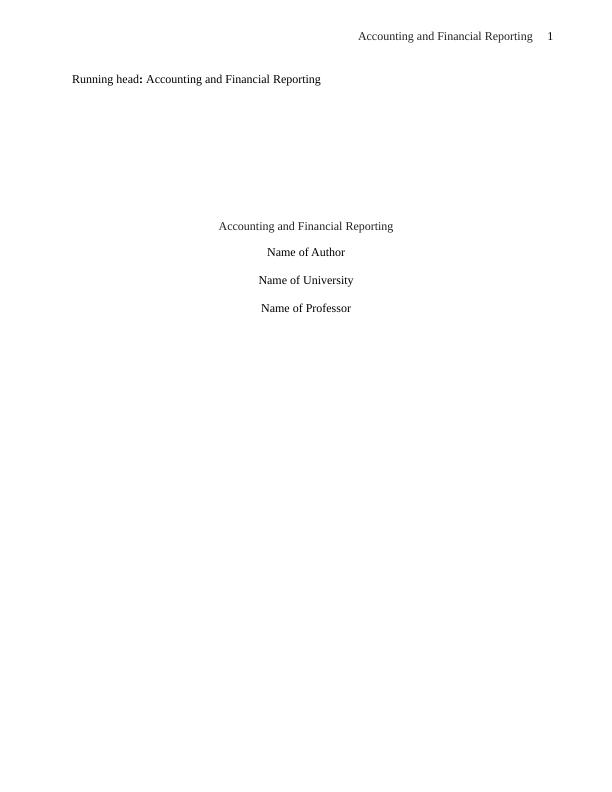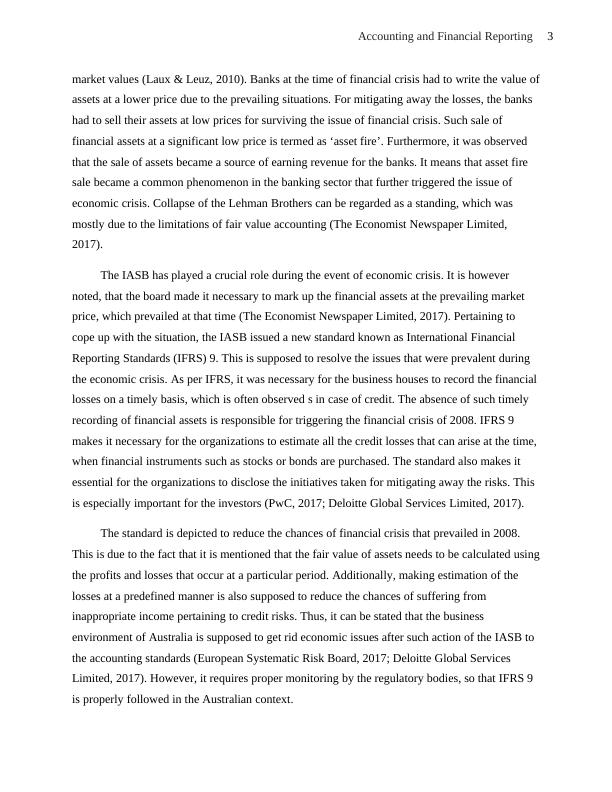Study on Accounting and Financial Reporting
Added on 2020-03-23
6 Pages2073 Words29 Views
1Accounting and Financial Reporting
Running head: Accounting and Financial Reporting
Accounting and Financial Reporting
Name of Author
Name of University
Name of Professor
Running head: Accounting and Financial Reporting
Accounting and Financial Reporting
Name of Author
Name of University
Name of Professor

2Accounting and Financial Reporting
Accounting and Financial Reporting
Introduction
The present study focuses on the various tenets of the accounting standards, which are
published by the International Accounting Standards Board (IASB). For instance, it is
determined that in what manner the use of fair-value of accounting had led to the issue of global
financial crisis (GFC) and the manner in which the intervention of the IASB can resolve the
issue. It has been discussed in the study various ways through which the accounting standards of
the IASB had to be modified due to the GFC. It is also determined that in what ways AASB can
use the IASB standards.
Part A
Accounting standards are depicted to have an impact on the global financial crisis that
occurred during the year 2008. More precisely, it can be stated that the crisis mostly happened
due to the use of fair-value accounting. Fair value accounting refers to the approach that involves
timely revaluation of the values pertaining to assets and liabilities. It enables to explore the actual
value of the assets and liabilities at the market price. For this reason, the method is also termed as
market-to-market accounting. The supporters of fair value accounting thus argued, that the
method enables to get insights regarding the present situation that prevails in the market
(Financial Times, n.d.; Tabără & Rusu, 2011).
On the contrary, the opponents of the theory clearly explain that fair value accounting
made the investors to consider inappropriate market value of the securities. This created
economic turbulences such as bankruptcy that raised the issue of for the banking sector. This is
due to the fact that various types of securities were present in the market were valued at an
inappropriate manner due to which the investor was unable to get proper return on their
investments. Low return reduced the ability of the investors to repay back their debts, as they had
low income. Such instances raised the amount of bad debts of the banks (Small, 2012).
The problem with fair value accounting is that during economic upswings, the tendency of
the firms to adopt debt was considered as a major form of financing. Such situations can lead to
losses, when the economy is in boom situations. Prices of financial assets during the crisis were
mostly done with the help of fair-value accounting, as depicted from the excessive reliance on
Accounting and Financial Reporting
Introduction
The present study focuses on the various tenets of the accounting standards, which are
published by the International Accounting Standards Board (IASB). For instance, it is
determined that in what manner the use of fair-value of accounting had led to the issue of global
financial crisis (GFC) and the manner in which the intervention of the IASB can resolve the
issue. It has been discussed in the study various ways through which the accounting standards of
the IASB had to be modified due to the GFC. It is also determined that in what ways AASB can
use the IASB standards.
Part A
Accounting standards are depicted to have an impact on the global financial crisis that
occurred during the year 2008. More precisely, it can be stated that the crisis mostly happened
due to the use of fair-value accounting. Fair value accounting refers to the approach that involves
timely revaluation of the values pertaining to assets and liabilities. It enables to explore the actual
value of the assets and liabilities at the market price. For this reason, the method is also termed as
market-to-market accounting. The supporters of fair value accounting thus argued, that the
method enables to get insights regarding the present situation that prevails in the market
(Financial Times, n.d.; Tabără & Rusu, 2011).
On the contrary, the opponents of the theory clearly explain that fair value accounting
made the investors to consider inappropriate market value of the securities. This created
economic turbulences such as bankruptcy that raised the issue of for the banking sector. This is
due to the fact that various types of securities were present in the market were valued at an
inappropriate manner due to which the investor was unable to get proper return on their
investments. Low return reduced the ability of the investors to repay back their debts, as they had
low income. Such instances raised the amount of bad debts of the banks (Small, 2012).
The problem with fair value accounting is that during economic upswings, the tendency of
the firms to adopt debt was considered as a major form of financing. Such situations can lead to
losses, when the economy is in boom situations. Prices of financial assets during the crisis were
mostly done with the help of fair-value accounting, as depicted from the excessive reliance on

3Accounting and Financial Reporting
market values (Laux & Leuz, 2010). Banks at the time of financial crisis had to write the value of
assets at a lower price due to the prevailing situations. For mitigating away the losses, the banks
had to sell their assets at low prices for surviving the issue of financial crisis. Such sale of
financial assets at a significant low price is termed as ‘asset fire’. Furthermore, it was observed
that the sale of assets became a source of earning revenue for the banks. It means that asset fire
sale became a common phenomenon in the banking sector that further triggered the issue of
economic crisis. Collapse of the Lehman Brothers can be regarded as a standing, which was
mostly due to the limitations of fair value accounting (The Economist Newspaper Limited,
2017).
The IASB has played a crucial role during the event of economic crisis. It is however
noted, that the board made it necessary to mark up the financial assets at the prevailing market
price, which prevailed at that time (The Economist Newspaper Limited, 2017). Pertaining to
cope up with the situation, the IASB issued a new standard known as International Financial
Reporting Standards (IFRS) 9. This is supposed to resolve the issues that were prevalent during
the economic crisis. As per IFRS, it was necessary for the business houses to record the financial
losses on a timely basis, which is often observed s in case of credit. The absence of such timely
recording of financial assets is responsible for triggering the financial crisis of 2008. IFRS 9
makes it necessary for the organizations to estimate all the credit losses that can arise at the time,
when financial instruments such as stocks or bonds are purchased. The standard also makes it
essential for the organizations to disclose the initiatives taken for mitigating away the risks. This
is especially important for the investors (PwC, 2017; Deloitte Global Services Limited, 2017).
The standard is depicted to reduce the chances of financial crisis that prevailed in 2008.
This is due to the fact that it is mentioned that the fair value of assets needs to be calculated using
the profits and losses that occur at a particular period. Additionally, making estimation of the
losses at a predefined manner is also supposed to reduce the chances of suffering from
inappropriate income pertaining to credit risks. Thus, it can be stated that the business
environment of Australia is supposed to get rid economic issues after such action of the IASB to
the accounting standards (European Systematic Risk Board, 2017; Deloitte Global Services
Limited, 2017). However, it requires proper monitoring by the regulatory bodies, so that IFRS 9
is properly followed in the Australian context.
market values (Laux & Leuz, 2010). Banks at the time of financial crisis had to write the value of
assets at a lower price due to the prevailing situations. For mitigating away the losses, the banks
had to sell their assets at low prices for surviving the issue of financial crisis. Such sale of
financial assets at a significant low price is termed as ‘asset fire’. Furthermore, it was observed
that the sale of assets became a source of earning revenue for the banks. It means that asset fire
sale became a common phenomenon in the banking sector that further triggered the issue of
economic crisis. Collapse of the Lehman Brothers can be regarded as a standing, which was
mostly due to the limitations of fair value accounting (The Economist Newspaper Limited,
2017).
The IASB has played a crucial role during the event of economic crisis. It is however
noted, that the board made it necessary to mark up the financial assets at the prevailing market
price, which prevailed at that time (The Economist Newspaper Limited, 2017). Pertaining to
cope up with the situation, the IASB issued a new standard known as International Financial
Reporting Standards (IFRS) 9. This is supposed to resolve the issues that were prevalent during
the economic crisis. As per IFRS, it was necessary for the business houses to record the financial
losses on a timely basis, which is often observed s in case of credit. The absence of such timely
recording of financial assets is responsible for triggering the financial crisis of 2008. IFRS 9
makes it necessary for the organizations to estimate all the credit losses that can arise at the time,
when financial instruments such as stocks or bonds are purchased. The standard also makes it
essential for the organizations to disclose the initiatives taken for mitigating away the risks. This
is especially important for the investors (PwC, 2017; Deloitte Global Services Limited, 2017).
The standard is depicted to reduce the chances of financial crisis that prevailed in 2008.
This is due to the fact that it is mentioned that the fair value of assets needs to be calculated using
the profits and losses that occur at a particular period. Additionally, making estimation of the
losses at a predefined manner is also supposed to reduce the chances of suffering from
inappropriate income pertaining to credit risks. Thus, it can be stated that the business
environment of Australia is supposed to get rid economic issues after such action of the IASB to
the accounting standards (European Systematic Risk Board, 2017; Deloitte Global Services
Limited, 2017). However, it requires proper monitoring by the regulatory bodies, so that IFRS 9
is properly followed in the Australian context.

End of preview
Want to access all the pages? Upload your documents or become a member.
Related Documents
Accounting Standard’s Role in GFC Reportlg...
|8
|2069
|86
Fair Value Measurement: Literature Review and Contextual Issueslg...
|6
|1639
|273
Fair Value Accounting: A Global Perspectivelg...
|7
|1967
|147
Global Financial Crisislg...
|10
|2767
|42
Financial Accounting for Business Combinations Assignmentlg...
|7
|1944
|21
Financial crisis 2008 causes and effects : Assignmentlg...
|14
|2893
|287
